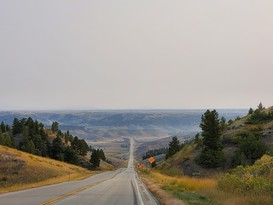
Welcome to the Rangeland Resources Program newsletter!
Featuring key information about our program, notifications about upcoming events, and news blasts, this newsletter will keep you up to speed with everything Montana rangeland. If you have any suggestions for future newsletters, please contact Stacey Barta at SBarta@mt.gov.
This is often my office view this time of year, I was glad to be out for a few days! That is Slippery Ann at the bottom.
|

Craig and Conni French Receive Montana Leopold Conservation Award
2020 Montana Leopold Conservation Award Winner Video
Craig and Conni French always considered themselves good land stewards, but six years ago things really began to change. They came to see their cattle ranch’s fate was tied to healthy soils and grasses.
Their introduction to holistic ranch management techniques called into question long-held, traditional ways of thinking. The drastic changes that followed required a leap of faith for the fourth-generation ranchers. They traded harvesting hay for grazing methods that let their cattle harvest the forage themselves. Such changes didn’t happen overnight, and each came with its own risk and learning curve.
The use of cell grazing (a form of rotational grazing that moves a large herd frequently to new pastures) allows more recovery time for perennial vegetation to flourish on a semi-arid, brittle environment of short prairie grass. This results in better forage and wildlife habitat.
Craig and Conni make decisions not just with their cattle herd’s health in mind, but also the impact on soil, insects and wildlife. Temporary electric fence has replaced permanent fencing to reduce conflicts with wildlife. Targeted grazing of non-native grasses has improved habitat for grassland birds and sage grouse.
With assistance from the NRCS’s Environmental Quality Incentives Program, they moved livestock water tanks and windbreaks away from a creek. Beaver Creek flows through three miles of the ranch and its health is a conservation priority for the French family. The return of willow trees along the creek’s banks is a sign their efforts are paying off.
Their voluntary 30-year conservation lease with Montana’s Fish, Wildlife, and Parks ensures their land’s native grassland and sagebrush will remain uncultivated and undeveloped. Likewise, hunters are allowed access to their ranch’s thriving wildlife populations through enrollment in the state’s Block Management program. The French's have also agreed to sustain and improve habitat for four species of imperiled grassland birds and sage-grouse, and have their numbers surveyed.
As long-time members of The Ranchers Stewardship Alliance, a rancher-led conservation group that aims to educate within and outside the ranch community, the Frenches share their experience with holistic management, cell grazing and other innovative conservation practices.Collaboration with federal and state agencies, non-profits and other ranchers is critical for them to achieve conservation success.
Earlier this year, Montana landowners were encouraged to apply (or be nominated) for the award. Applications were reviewed by an independent panel of agricultural and conservation leaders.
Among the many outstanding Montana landowners nominated for the award were finalist Pete and Meagan Lannan of Livingston in Park County. The 2019 recipients were Bill and Dana Milton of Roundup in Musselshell County.
The Montana Leopold Conservation Award is made possible through the generous support of American Farmland Trust, Sand County Foundation, the Office of Governor Steve Bullock, Montana Department of Agriculture, Montana Department of Natural Resources and Conservation’s Rangeland Resources Committee, Northwest Farm Credit Services, Sibanye-Stillwater, World Wildlife Fund, USDA-Natural Resources Conservation Service, McDonald’s, Montana Farm Bureau Federation, Montana Grazing Lands Conservation Initiative, Ranchers Stewardship Alliance, Rocky Mountain Elk Foundation, Society for Range Management – Northern Great Plains Section, Soil and Water Conservation Society, and The Wildlife Society of Montana.
|
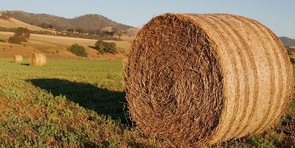
What the Hay?
Do you know about he Montana Department of Agriculture Hay Hotline? Not just for finding, selling or donating hay, but also has resources for pasture. Since many parts of Montana have suffered greatly at the mandibles of hoppers, this may be a resource for producers out here looking for forage or pasture. MDA Hay Hotline https://agr.mt.gov/Hay-Hotline
|
Are you a farmer or rancher whose operation has been directly impacted by the coronavirus pandemic? USDA is implementing Coronavirus Food Assistance Program 2 for agricultural producers who continue to face market disruptions and associated costs because of COVID-19
President Donald J. Trump and U.S. Secretary of Agriculture Sonny Perdue announced on September 17 that USDA will implement an expansion of the Coronavirus Food Assistance Program. Coronavirus Food Assistance Program 2, CFAP 2, will provide producers with financial assistance that gives them the ability to absorb some of the increased marketing costs associated with the COVID-19 pandemic.
CFAP 2 follows the first round of CFAP, which had an application period of May 26 through September 11. You can learn more about USDA’s initial Coronavirus Food Assistance Program by visiting farmers.gov/cfap1.
 |
|
Innovative Conservation on the Prairie
Unique Partnership Helps Ranchers and Climate
The Nature Conservancy (TNC) has completed an innovative, multi-year plan to protect vital grassland habitat by working in a unique partnership with Montana ranchers. The project also helps to fight climate change.
After purchasing 4,340 acres in Phillips County, south of Malta in 2019, TNC did the opposite of what is often expected of conservation organizations. We sold it to neighboring ranch families, with a conservation easement in place. As part of the partnership, those families have, in turn, placed easements on some of the land they already owned. Full story here.
|
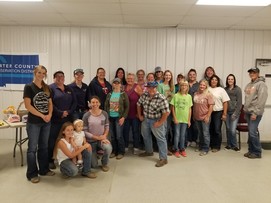
Ladies on the Range
Stephanie Carroll-Carter County Conservation District
The Carter County Conservation District along with the local NRCS office hosted a fun and educational event, focusing on women in agriculture. The tour started off at the Bonsell Ranch. We had the opportunity to tour their hoop house, which was in full production. The ladies then focused on weed management and plant ID. We finished the event at the Ekalaka Event Center where we focused on Farm and Ranch Safety, Canning, Gardening and Animal Health. To end the evening, the Wagon Wheel Café put together an amazing meal and door prizes were handed out. The Conservation District would like to extend a sincere Thank You to all those who attended and helped put this day together and for continuing to promote conservation education in Carter County.
If you or your organization are interested in hosting a similar event please contact Stacey at sbarta@mt.gov for more information.
|
Long Term Study on Integrated Leafy Spurge Management - MSU- Jane Mangold
October Weed Post discusses the results of a long-term study on integrated management of leafy spurge in western Montana. You can access the post at http://www.msuinvasiveplants.org/extension/monthly-weed-posts/202010mwp-leafy-spurge-management.html [msuinvasiveplants.org]
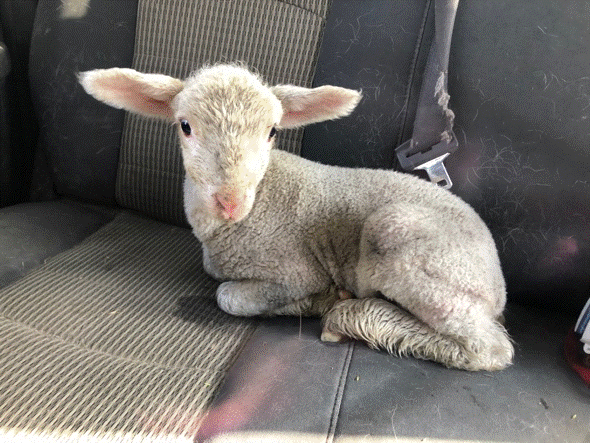
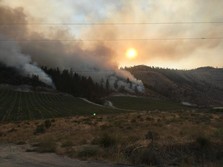
Fires and Feathers
More than 300,000 acres have burned in Washington state since Labor Day, when high winds and temperatures created perfect conditions for fast, destructive fire. Ashley Ahearn [birdnote.org] headed to Bridgeport, Washington, where the Cold Springs Fire has burned more than 170,000 acres and is still threatening homes and wildlife. This 4 minute listen speaks to the importance of everyone on a landscape. cold-springs-fire-threatens-homes-and-sage-grouse. This article was originally published on WBUR.org.
|
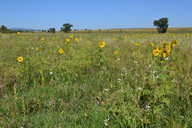
Conservation for the Future: Ray Banister, Wibaux, MT
USDA- NRCS Montana
Ray Banister ranches south of Wibaux, MT. He has practicing "boom and bust" grazing management for more than 30 years on his ranch and has seen the impacts of the management style over time on soil health, plant health and productivity, and animal health and performance. NRCS has recently set up a site to conduct soil dynamic properties studies. Ray Banister.
|
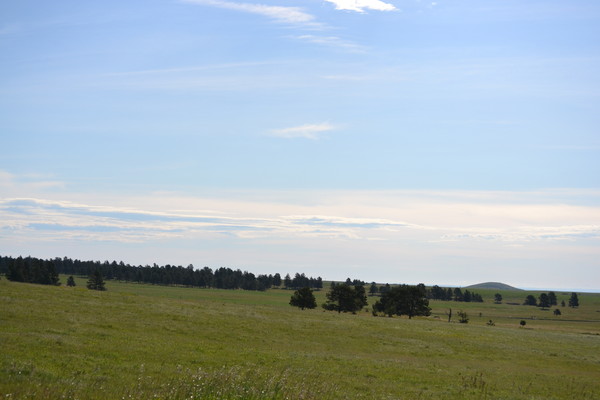
Livestock Grazing on Public Lands-Things Every Rancher Should Know- Dan Scott Ranch Management October Natural Resource Policy Seminar Series
https://tippetrise.org/podcasts/a-love-of-the-land [tippetrise.org]
https://tippetrise.org/podcasts/a-healthy-forest [tippetrise.org]
How palates link soil, plants, herbivores and humans by Dr. Fred Provenza
Western Governors’ Association hosted a webinar to launch a new Toolkit for Invasive Annual Grass Management in the West [westgov.org]
“Out West” podcast, The Buzz About Murder Hornets – Separating Fact from Fiction [westgov.org]
Land Sustainability and Stewardship
Watershed Stories - Montana Watershed Coordination Council recently produced watershed stories, check them out.
Rangeland Podcasts- The Art of Range podcast provides education through conversation with some of the brightest minds in rangeland management.
This video covers field characteristics important for identifying four non-native annual grasses invasive in Montana: cheatgrass (Bromus tectorum), Japanese brome (Bromus japonicus), ventenata (Ventenata dubia), and medusahead (Taeniatherum caput-medusae).

Coordinator Corner
|
September, one of my most favorite times of the year. I love the transition into changing colors, the sound of elk bugling( I can hear them from my porch in Manhattan) and the smell of grass and leaves. I hope you are able to enjoy what the season offers.
Happy Trails. -Stacey
NRCS Events. Calendar of conservation workshops and training
Natural Resource & Policy Series- Dan Scott Ranch Management Program
Oct. 6-8 2020 NAISMA Annual Conference is the organization’s 27th Annual Conference and will be co-hosted with the Montana Invasive Species Council
Summit to Stream Symposium Oct 14-16, Butte MT -This is going Virtual
2020 Virtual Wild Pig Conference
Stacey Barta, Program Coordinator
220 W. Lamme, Suite 1A
Bozeman, MT 59715
(406) 594-8481
SBarta@mt.gov
Rangeland Resources Committee:
John Hollenback, Chairman
Steve Hedstrom, Vice Chairman
Diane Ahlgren
Noel Keogh
Connie Iversen
Sigurd Jensen
|